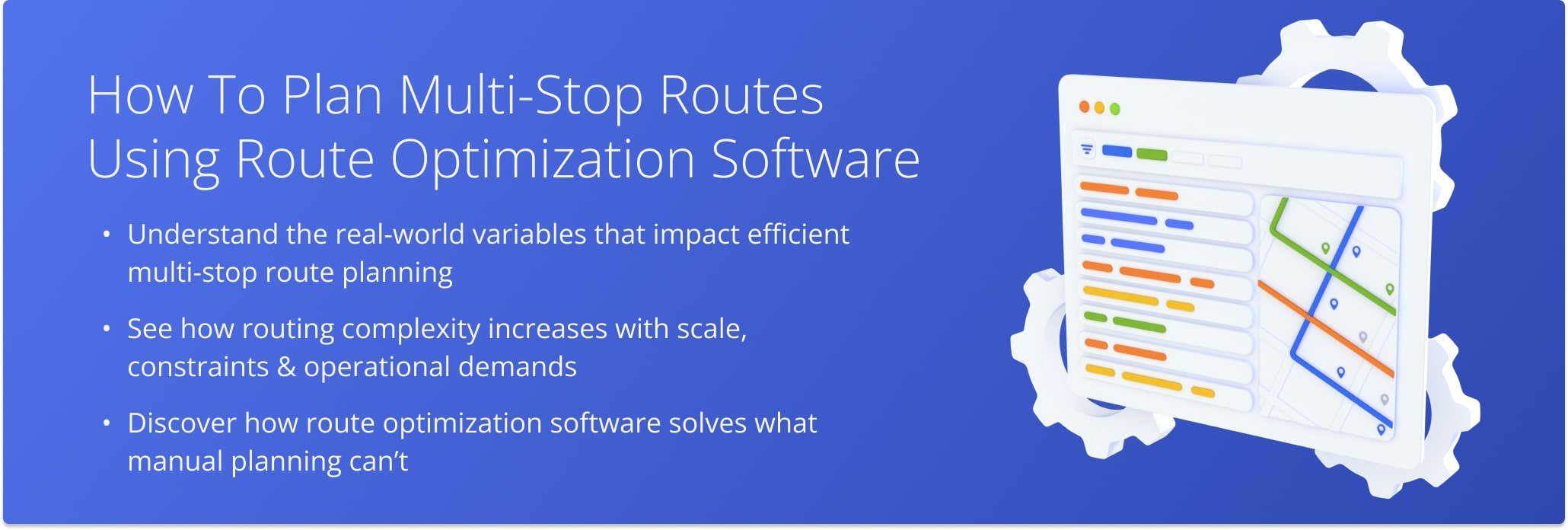How To Use Route Optimization Software For Multi-Stop Route Planning
Planning multi-stop routes manually or with Google Maps is inefficient, especially for delivery and field service businesses. Google Maps limits the number of stops and doesn’t optimize for cost, time, or fleet constraints. Route optimization sofware automates route planning, accounting for vehicle capacity, driver availability, traffic, and customer time windows. With optimized delivery routes, businesses can reduce fuel and labor costs, improve fleet performance, and ensure timely deliveries. This guide explains how to use route planning software to create the most efficient multi-stop routes in seconds.

Table of Contents
Key Variables In Multi-Stop Route Planning
Efficient multi-stop route planning requires considering these critical factors:
- Vehicle capacity: Maximum weight, cubic volume, and number of items per vehicle
- Traffic restrictions: Congestion, rush hours, and near real-time traffic updates
- Weather conditions: Rain, snow, hail, storms, and slippery roads
- Driver and vehicle availability: Scheduling constraints and shift hours
- Customer time windows: Hours when deliveries or service visits are allowed
- Routing preferences: Avoiding tolls, highways, or left/right turns as needed
Example: Multiple Destinations Routing Challenge
Imagine servicing 100 customers in a single day. Each customer has specific visitation hours, vehicles have different capacities, and drivers are limited. Add unpredictable weather and traffic, and it becomes nearly impossible to manually plan the most efficient routes.
Goals for multi-destination route planning include:
- Using fleet resources at full capacity
- Sequencing stops in the most cost-efficient and time-effective order
- Complying with vehicle-specific road restrictions
- Minimizing wait time between stops
Route optimization software solves this problem by processing millions of potential route combinations and identifying the most feasible multi-stop routes, effectively handling both the Vehicle Route Problem (VRP) and the Travelling Salesman Problem (TSP).
Multi-Stop Route Planning Software
A multiple stop route planner automates route creation for delivery and field service teams. Modern route planning software can process thousands of addresses in minutes, generating cost-efficient, optimized routes that reduce fuel and payroll expenses.
Benefits include:
- Sequencing stops in the most efficient order
- Reducing operating costs, including fuel and labor
- Streamlining supply chain and delivery workflows
- Improving visibility into fleet and team operations
- Enhancing customer satisfaction
- Delivering more packages with fewer resources
- Accounting for traffic, weather, and other unpredictable variables
Start a free trial of our route optimization app and see how it can streamline your multi-stop route planning in real time.
Visit Route4Me's Marketplace to Check out Associated Modules:
Last Updated: